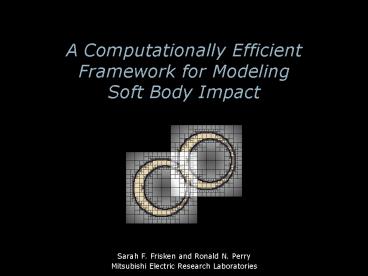A Computationally Efficient Framework for Modeling Soft Body Impact - PowerPoint PPT Presentation
Title:
A Computationally Efficient Framework for Modeling Soft Body Impact
Description:
A Computationally Efficient Framework for Modeling Soft Body Impact Sarah F. Frisken and Ronald N. Perry Mitsubishi Electric Research Laboratories – PowerPoint PPT presentation
Number of Views:82
Avg rating:3.0/5.0
Title: A Computationally Efficient Framework for Modeling Soft Body Impact
1
A Computationally Efficient Framework for
Modeling Soft Body Impact
- Sarah F. Frisken and Ronald N. Perry
- Mitsubishi Electric Research Laboratories
2
Modeling Soft Body Impact
- Detect collisions between interacting bodies
- Model global motion changes (e.g., position and
velocity) - Apply a dynamic simulation method
- Model local shape changes (i.e., deformation)
- Apply a deformation method that may be
- Non-physical (e.g. control point-based)
- Physically plausible (e.g., FFD)
- Physically realistic and dynamic (e.g. FEM)
3
Modeling Soft Body Impact
- Wide range of applications and goals
- e.g., editing tools in Maya deform surfaces by
moving nearby control points - e.g., computer simulation for games may
approximate or exaggerate physics - e.g., protein docking for molecular modeling
requires accurate modeling
4
An Observation
- Common requirements for modeling soft body
interactions - Detect collisions between interacting soft bodies
- Compute impact forces
- Compute deformation forces and/or contact
deformation
5
A Proposal
- Represent Objects with Adaptively Sampled
Distance Fields (ADFs) - Compact representation of detailed shape
- Efficient collision detection
- Straightforward force computation
- A means for estimating contact deformation
6
Distance Fields
- Specify the (possibly) signed distance to a shape
-130 -95 -62 -45 -31 -46 -57 -86
-129
-90
-90 -49 -2 17 25 16 -3
-43 -90
-71 -5 30 -4 -38 -32 -3
-46 12 1 -50 -93 -3
-65
20
2D shape with sampled distances to its edge
Regularly sampled distance values
2D distance field
7
Distance Fields
- Advantages
- Provide trivial inside/outside and proximity
tests for collision detection - Penalty-based contact forces can be computed for
penetrating bodies using the distance field and
its gradient - Implicit nature of the distance field provides a
means for estimating contact forces
8
Distance Fields
- Disadvantages of regularly sampled distance
fields - High sampling rates are required to representing
objects with fine detail without aliasing - For regularly sampled volumes, high sampling
rates require large volumes which are slow to
process and render - Detail is limited by the fixed volume resolution
9
Adaptively Sampled Distance Fields
- Detail-directed sampling
- High sampling rates only where needed
- Spatial data structure (e.g., an octree)
- Fast localization for efficient processing
- Reconstruction method (e.g., trilinear
interpolation) - For reconstructing the distance field and its
gradient from the sampled distance values
10
Advantages of ADFs
ADFs provide Spatial hierarchy Distance
field Object surface Object interior Object
exterior Surface normal (gradient at surface)
Direction to closest surface point (gradient off
surface)
ADFs consolidate the data needed to represent
complex objects
11
Collision Detection
Use ADF spatial hierarchy for efficient
localization of potential collision
12
Collision Detection
- Collision occurs in the overlap region of the
ADFs - Overlap region is determined using simple CSG
operations - Full geometry of the overlap region is available
- Can use the overlap region of ADF offset surfaces
for proximity tests
13
Contact Forces
- Compute contact forces in the overlap region
- Derive force vectors acting on penetrating body
from distance field of the penetrated body
Forces are computed in the overlap region
14
Contact Forces
- fV(p) ? dU(p) ?dU(p)
- Compute contact forces
- At surface points (shown here) OR
- Over the entire overlap region (more accurate?)
- Apply a deformation method (e.g. FEM)
- Derive impact forces
- From contact forces and surface normals
- Apply a dynamic simulation method
Deformation forces on the surface SV due to
penetration of U by V
15
Modeling Deformation using Implicit Functions
- Approximate contact deformation by combining
distance fields in the overlap region - dU(p) min(dU(p), ? dU(p) - (1 - ?) dV(p)), ? ?
(0,1)
16
Modeling Deformation using Implicit Functions
- Achieve different effects depending on method for
combining distance fields
Material compression with similar materials
Material compression with V softer than U
Volume preservation (after Cani, Graphics
Interface 98)
17
Summary
- ADFs
- Use distance fields to represent shape
- Adaptive sampling provides efficient memory usage
and reduced computation so we can represent very
detailed shapes - Spatial data structure provides fast localization
and processing - An efficient framework for soft body impact
- Fast collision detection
- Straightforward force computation
- A means for estimating contact deformation
18
Preliminary Results
- Interactive computation and display of 2D contact
forces
Interactive force computation on complex shapes
19
Preliminary Results
- Can achieve detailed 3D contact deformation
A soft sphere after impact with a hard ADF model
A soft sphere after impact with a soft ADF model
20
The End































